| Key Notes: • The best option for developing and marketing digital goods is Kajabi. • Shopify is the better option if you plan to sell physical products only. |
When it comes to building an online business, one of the most important decisions you have to make is choosing the right platform. The two popular options out there are Kajabi and Shopify. Both platforms offer unique features and cater to different types of businesses. In this article, we will compare these two platforms and help you determine which one is better for your specific needs.
Kajabi vs Shopify: Quick Comparison
Before we dig into the details, let’s look at a quick side-by-side comparison of Kajabi and Shopify:
| Feature | Kajabi | Shopify |
| Current Promotion | 30-day free trial | 3-day free trial plus one month for $1 |
| Funnels | ✅ | ❌ |
| Website Builder | ✅ | ✅ |
| Templates and Blueprints | ✅ | ✅ |
| Email Campaigns | ✅ | ✅ |
| Blogs | ✅ | ✅ |
| Courses | ✅ | ❌ |
| Communities | ✅ | ❌ |
| Coaching | ✅ | ❌ |
| Live Video Streaming | ✅ | ❌ |
| Automation | ✅ | ✅ |
| Analytics | ✅ | ✅ |
| Native Checkout | ❌ | ✅ |
| CRM | ✅ | ✅ |
| Integrations | ✅ | ✅ |
As you can see, Kajabi offers more features for creating and managing digital products, while Shopify focuses on e-commerce tools for physical products.
What Is Kajabi?
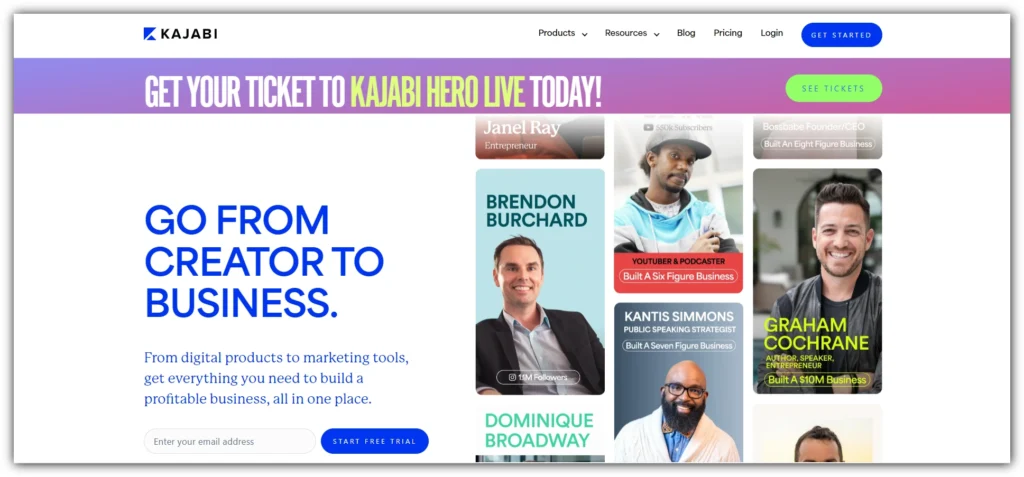
Kajabi is a versatile platform that simplifies the creation, sales, and marketing of digital products. As an “all-in-one” solution, it offers everything you need to build and manage your online business seamlessly. Whether you’re looking to create and sell online courses, develop a membership site, or run effective email marketing campaigns, Kajabi provides a comprehensive set of tools to handle it all.
With Kajabi, you can design and launch your digital products without relying on third-party software. This integrated approach streamlines the process, saving you time and effort while ensuring a cohesive user experience. The platform’s intuitive interface makes it easy to create and organize content, manage your audience, and track performance metrics.
Kajabi’s features include customizable website templates, automation tools for email marketing, and robust analytics to measure your success. This means you can focus on delivering valuable content to your audience while Kajabi handles the technical aspects.
What Is Shopify?

Shopify is a popular e-commerce platform that helps entrepreneurs build and manage online stores. It offers an extensive range of tools to create a professional-looking website, sell products, and track sales. Shopify powers over 1 million businesses worldwide, making it one of the leading options for online retailers.
With Shopify, you can:
- Create an online store
- Sell physical or digital products
- Process payments
- Manage inventory
- Handle shipping
- Market your products
Shopify is excellent because it provides all the tools necessary to run an online store, even if you don’t have technical skills. It’s designed to make e-commerce accessible to everyone. With its user-friendly interface, you can quickly set up your store and start selling products.
How Are Kajabi and Shopify Similar?
Even though Kajabi and Shopify are designed for different purposes, they do have some things in common:
- Subscription-based: Both platforms charge a monthly or yearly fee to use their services.
- User-friendly interfaces: Kajabi and Shopify both have modern, easy-to-use dashboards. They use drag-and-drop tools to help you build web pages and set up products.
- E-commerce focus: While they approach it differently, both platforms are all about helping you sell stuff online.
- Marketing tools: Each platform offers features to help you promote and sell your products, like email marketing and analytics.
- Website building: Both Kajabi and Shopify let you create a website for your business without needing to know how to code.
So while they’re different in many ways, Kajabi and Shopify share these basic features that make them popular choices for online businesses.
Key Differences Between Kajabi and Shopify
Kajabi and Shopify serve different purposes and cater to distinct needs. Kajabi is designed specifically for creating and selling digital products such as online courses, coaching sessions, and membership sites. It provides all the tools you need to develop and manage these products within one platform.
In contrast, Shopify is dedicated to e-commerce, focusing primarily on selling physical products. While Shopify can handle digital product sales, it does not offer built-in tools for creating digital products. Instead, you need to rely on third-party apps, including Kajabi, to develop and manage digital content.
Additionally, Kajabi does not directly support the sale of physical products. If you want to sell physical goods through Kajabi, you would need to integrate with Shopify by adding a “buy” button to connect the two platforms. This integration allows you to combine Kajabi’s digital product capabilities with Shopify’s e-commerce features, offering a seamless shopping experience for both physical and digital products.
Understanding these differences is key to choosing the right platform for your business. In the next sections, we’ll dive deeper into specific features to help you make your decision.
Kajabi vs Shopify: Pricing
When it comes to choosing a platform for your online business, price is often a big factor. Let’s break down the pricing for Kajabi and Shopify.
Kajabi Pricing:
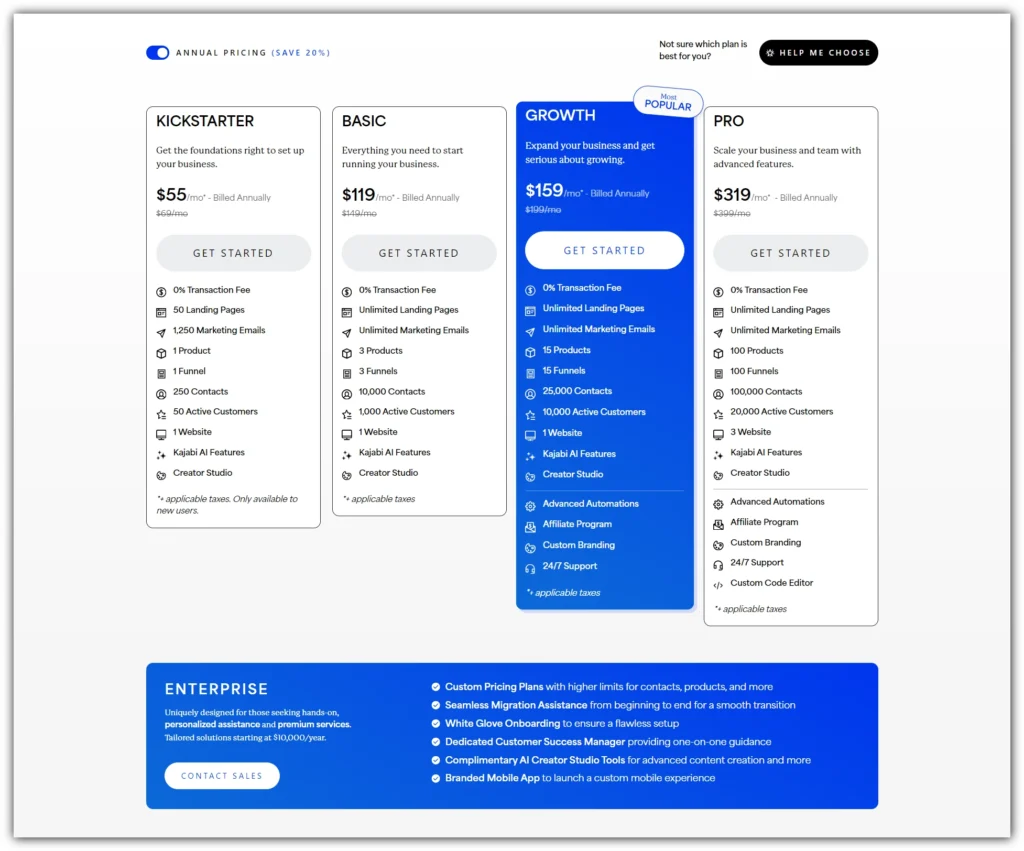
- Kickstarter Plan: $55/month
- Basic Plan: $119/month
- Growth Plan: $159/month
- Pro Plan: $319/month
- Enterprise Plan: Custom pricing (starting at $10,000/year)
Note: All plans offer a 20% discount if paid annually.
Shopify Pricing:
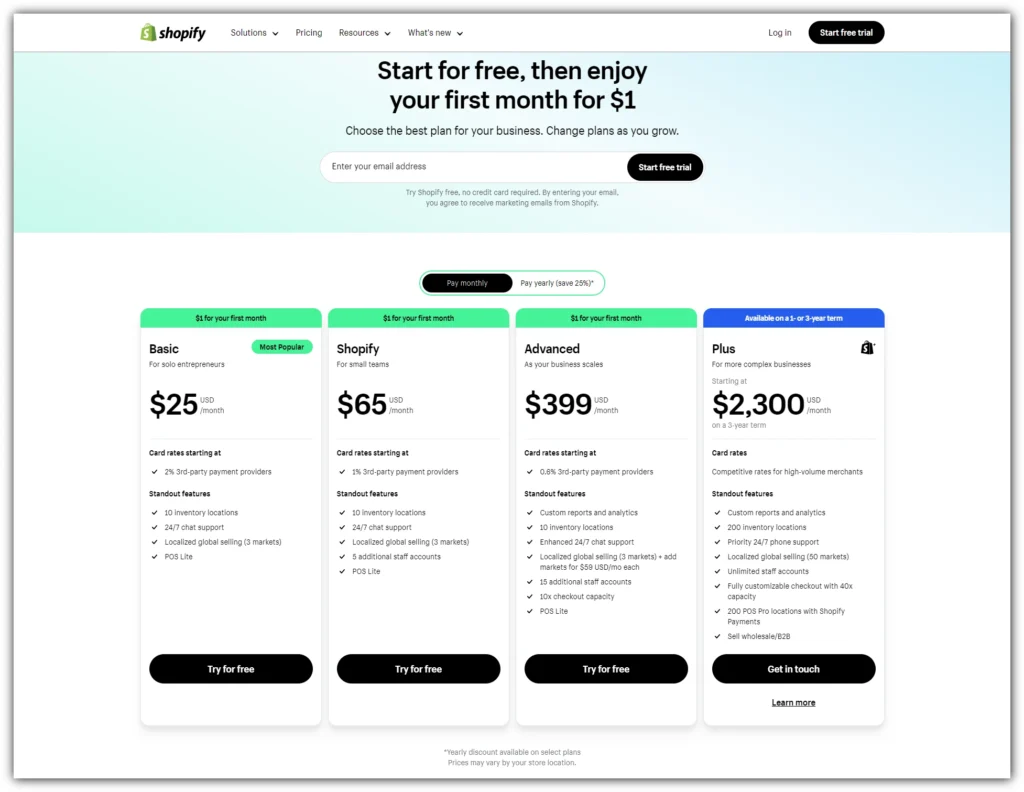
- Basic Plan: $25/month
- Shopify Plan: $65/month
- Advanced Shopify Plan: $399/month
- Shopify Plus Plan: Custom pricing (starting at $2,300/month)
Note: All plans offer a 25% discount if paid annually.
Winner: Shopify
While Kajabi and Shopify both offer a 30-day money-back guarantee, Shopify stands out with its more affordable entry-level plan and more generous annual discount. Additionally, Shopify’s introductory offer provides a longer trial period with a lower cost for the initial months, making it a better choice for those looking to get started affordably.
Kajabi vs Shopify: Page Builder and Templates
Both Kajabi and Shopify offer tools to help you build your website, but they approach it differently. Let’s see how they stack up:
Kajabi Page Builder and Templates

Kajabi really shines when it comes to templates and page building. Here’s why:
- Lots of modern templates: Kajabi offers a wide range of fresh, up-to-date designs for websites, landing pages, and blogs.
- Full-funnel blueprints: These are pre-made campaigns for specific goals, like giving away a freebie or launching a product. They’re super helpful for marketing newbies.
- Easy customization: Kajabi uses a drag-and-drop editor that’s intuitive and user-friendly. You can easily swap images, add or remove elements, and tweak designs to fit your brand.
- Workflow interface: This visual tool helps you see how all the pieces of your funnel fit together. It takes a bit of getting used to, but once you get it, it’s really powerful.
- No extra costs: All templates are included in your subscription. You don’t have to pay extra for premium designs.
Shopify Page Builder and Templates
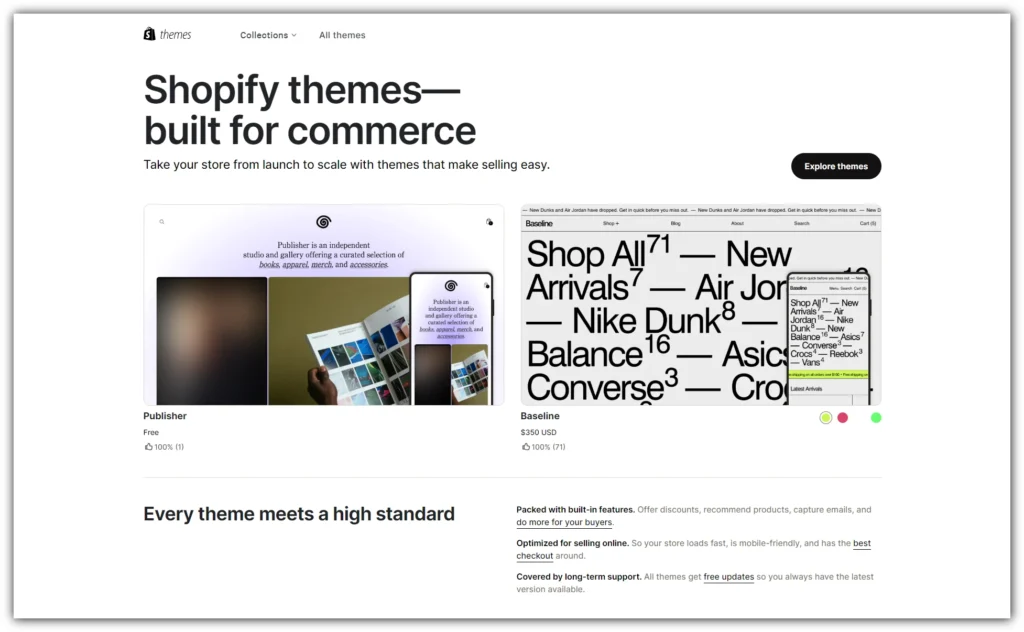
Shopify’s approach is more focused on e-commerce, but it still offers solid tools for building your online store:
- Theme-based design: Shopify calls its templates “themes.” These are designed for different types of online stores.
- Limited free options: There are only 12 free themes available. The rest cost money, starting at about $180 each.
- Drag-and-drop editor: Like Kajabi, Shopify has a visual editor. It’s powerful but can be a bit overwhelming at first because there are so many options.
- Automation templates: Shopify provides ready-to-use templates for automation workflows, which can be really helpful for running your store.
- E-commerce focus: All of Shopify’s themes are designed with selling in mind, so they include features like product galleries and shopping carts.
Both platforms give you the tools to create a professional-looking website. The main difference is in how much flexibility you have and what kind of site you’re trying to build.
Winner: Kajabi
Kajabi offers superior flexibility with its templates. Unlike Shopify, which primarily provides website templates, Kajabi includes fully developed campaign blueprints as part of its service. This means you have access to a broader range of tools for creating and managing digital products.
Moreover, Kajabi does not charge extra for these templates; they are included in your regular subscription fee. This added value makes Kajabi a more comprehensive and cost-effective choice for those seeking extensive customization and campaign management features.
Kajabi vs. Shopify: Community and Course Creation Features
Kajabi Course and Community Creation Features

Kajabi is renowned for its advanced digital product creation tools, making it a top choice for those focused on building high-quality online courses and communities.
The platform offers comprehensive features for developing courses, including lesson and module creation, video and audio content integration, assessments, and digital downloads. For coaches, Kajabi provides specialized tools such as a native live streaming feature and a smart booking calendar with scheduling capabilities.
Additionally, Kajabi’s community feature allows you to build Facebook-style groups directly on the platform. This functionality not only enhances engagement but also provides various monetization options for your communities, adding significant value to your digital product offerings.
Shopify Course and Community Creation Features

Shopify does not offer built-in tools for creating digital products such as courses or communities. While you can sell digital items like courses and downloads on Shopify, you need to use third-party software to create them. Shopify supports integration with various third-party apps that handle digital product creation and provide download links after purchase.
Winner: Kajabi
Kajabi clearly stands out in this category. Designed specifically for creating and managing digital products, Kajabi offers seamless tools for building courses, webinars, coaching sessions, and online communities.
Its all-in-one platform allows you to handle everything from content creation to sales and community engagement, making it the superior choice for those focused on digital product development.
So, which is better for courses and communities?
- If creating and selling courses or building paid communities is your main goal, Kajabi is the clear winner. It provides you with all the necessary tools in one place.
- If you’re primarily selling physical products and just want to offer a simple digital download now and then, Shopify could work. But for anything more complex, you’d need to use additional tools.
Kajabi vs Shopify: E-Commerce Capabilities
When it comes to selling products online, both Kajabi and Shopify have robust e-commerce capabilities. Here’s how they compare:
Kajabi E-Commerce Capabilities

Kajabi excels in selling digital goods with its comprehensive e-commerce features. The platform allows you to create and manage “offers,” which can include single items such as courses, digital downloads, or community access. You can also bundle multiple items into a single offer to provide more value to your customers.
However, Kajabi does not support the direct sale of physical products. To sell physical goods using Kajabi, you must integrate with Shopify. This integration requires a paid Shopify account, allowing you to handle physical product sales through Shopify while using Kajabi for your digital goods and marketing.
Shopify E-Commerce Capabilities

Shopify, designed specifically for e-commerce, offers a comprehensive range of features to support various business models. Whether you’re selling exclusively through social media, running a full-fledged online store, drop shipping, or offering print-on-demand products, Shopify provides the tools you need to succeed.
The platform supports large-scale e-commerce, allowing you to grow your business without limitations. You can sell globally and through multiple sales channels, ensuring flexibility in how and where you market and sell your products.
Winner: Shopify
While Kajabi excels in digital product sales, Shopify is the clear winner for e-commerce. It’s built to handle any type of product sale, from a few items to extensive catalogues. For a robust e-commerce experience with the capability to scale, Shopify is the platform of choice.
Kajabi vs Shopify: Payment and Checkout Tools
Kajabi Payment and Checkout Tools
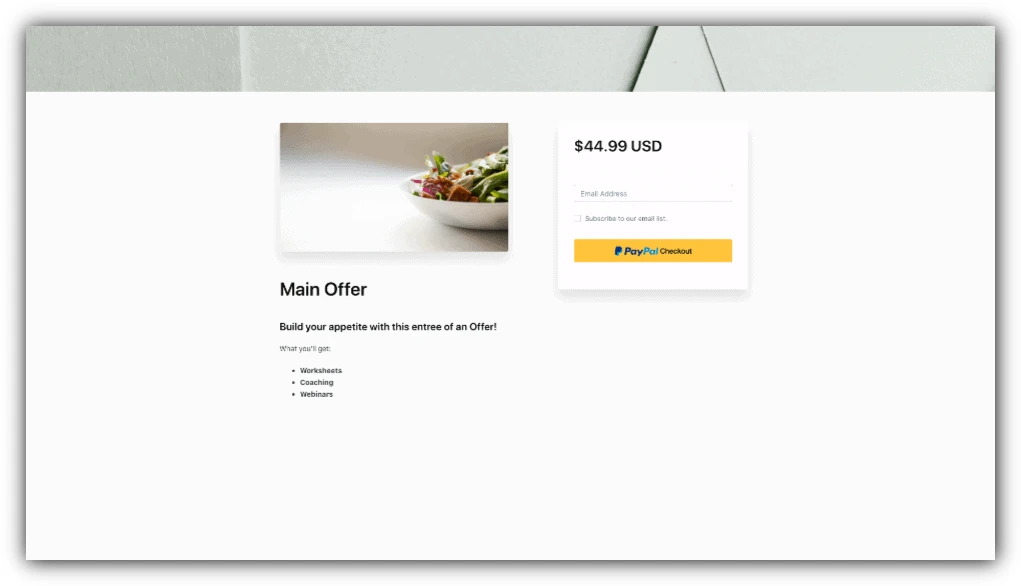
Kajabi does not offer its own checkout tool; instead, it integrates with payment processors like Stripe and PayPal for handling transactions. If you prefer a different payment gateway, you can connect it using Zapier.
Additionally, Kajabi allows you to use a Shopify Buy button. This button can be added to Kajabi-created web pages directly, without needing Zapier, enabling you to leverage Shopify’s payment capabilities within Kajabi.
Kajabi supports various payment options, including one-time payments and subscriptions. It also includes several sales aids such as upsells, order bumps, and coupons to enhance the purchasing experience and boost revenue.
Shopify Payment and Checkout Tools
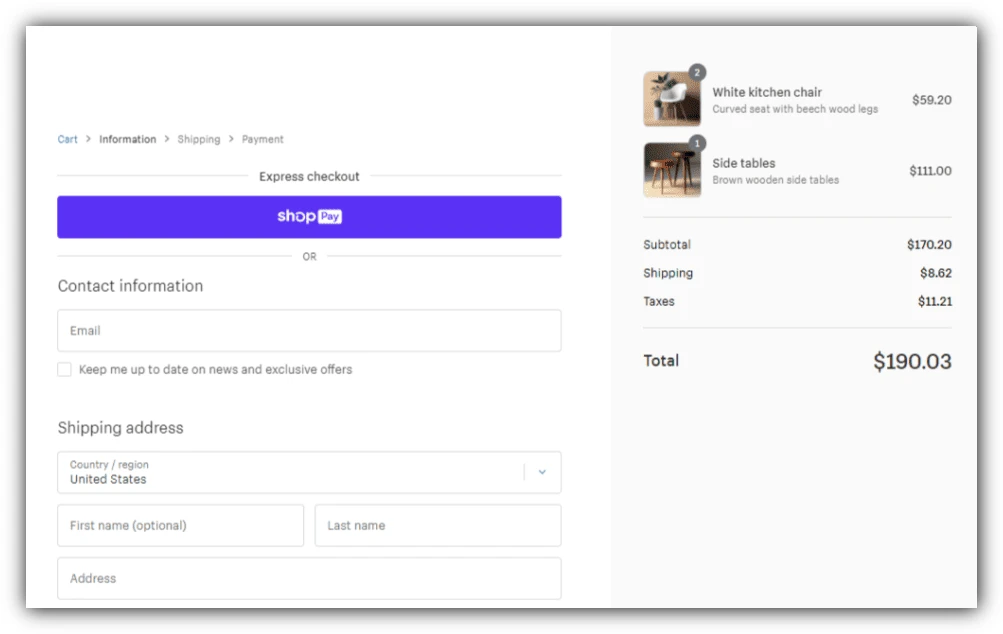
Shopify offers a built-in checkout system, allowing you to process payments directly without needing third-party apps, though you can integrate additional payment gateways if desired. The checkout process is streamlined with a single-page design and features time-saving elements like address autocomplete.
Shopify’s checkout also supports “one-click” payments, which simplifies the process for customers and helps reduce cart abandonment. For larger purchases, customers can opt for installment payments, making it easier to manage significant transactions.
The checkout system is highly customizable, allowing you to align it with your brand’s look and feel. Additionally, you can incorporate upsells, offer free samples, accept donations, apply coupon codes, and more, providing a flexible and enhanced purchasing experience for your customers.
Winner: Shopify
Kajabi’s payment options are more limited and require additional steps, like using Zapier for connecting to other payment gateways, which can complicate the process.
Shopify, however, excels with its streamlined, one-page checkout system. It includes features such as address autocomplete, one-click payments, and the ability to handle large purchases through installments. Shopify’s customizable checkout also offers upsells, free samples, donations, and coupon codes, providing a comprehensive and efficient solution to convert shopping carts into completed transactions.
Kajabi vs Shopify: Marketing Features
Kajabi Marketing Features

Kajabi provides an extensive suite of marketing tools to build and manage successful campaigns. Central to its marketing capabilities is the funnel builder, which enables you to create detailed sales funnels for various objectives. The workflow editor allows you to visualize your entire campaign, integrating both web pages and emails.
In addition to funnel creation, Kajabi offers robust email marketing tools with a wide range of templates. You can set up timed email sequences, send blasts, and personalize emails with videos, images, action buttons, and more.
Moreover, Kajabi lets you build full websites, single landing pages, and even a blog. You can enhance your web pages with forms, call-to-action buttons, countdown timers, pop-ups, and other elements to optimize engagement and conversions.
Shopify Marketing Features

Shopify offers a comprehensive email marketing tool, complete with visually appealing templates and options to create and automate full email campaigns. Additionally, Shopify allows you to set up a blog and embed lead-capture forms on your store’s website.
One of Shopify’s notable strengths is its seamless integration with major social media platforms. This feature facilitates running ads and showcasing products on Facebook, Instagram, TikTok, and more. The “one-tap” checkout option enhances the likelihood of sales conversions by simplifying the purchasing process.
Winner: Kajabi
While Shopify’s social media integrations are impressive, Kajabi provides a more rounded and flexible marketing suite. Kajabi’s multi-channel marketing capabilities and versatile sales funnels allow for more dynamic and varied marketing approaches, making it better suited for testing different methods and optimizing campaign performance.
Kajabi vs Shopify: Automation
Kajabi Automation
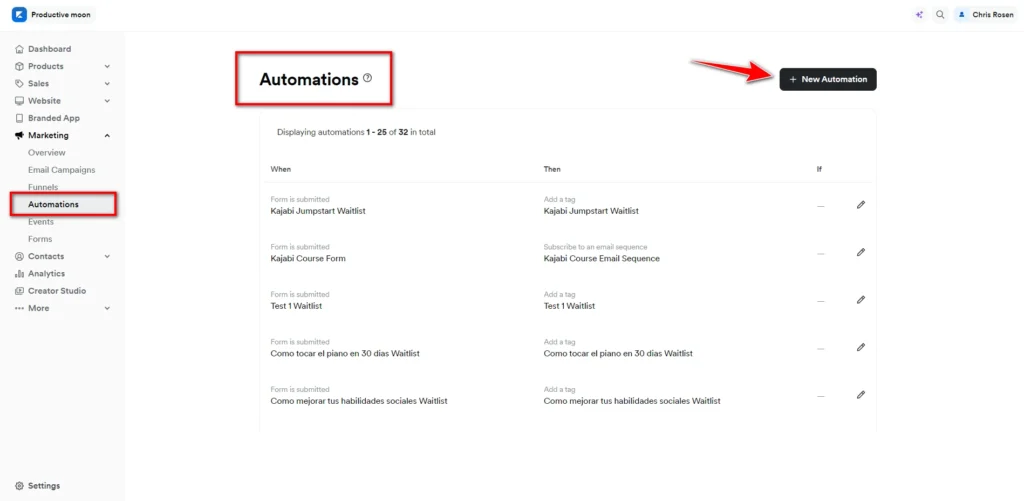
Kajabi offers advanced automation features that streamline repetitive tasks and enhance your marketing efficiency. You can automate various elements, including:
- Funnels
- Email campaigns
- Events
- Forms
- Offers
- Course lessons
For example, you can automate actions like subscribing or unsubscribing individuals from email campaigns and granting access to courses. Kajabi also allows for comprehensive automation of your workflows, enabling you to create fully automated marketing campaigns from start to finish. This setup is intuitive and well-supported by help guides and on-page prompts.
Shopify Automation

Shopify’s automation, known as “Shopify Flow,” operates similarly to Kajabi’s workflow tool by using triggers and events to create automated processes. However, Shopify Flow can be challenging to navigate due to its less user-friendly interface. To fully leverage Shopify Flow, you need to integrate with third-party apps, such as marketing software.
Shopify does offer templates for common tasks like customer rewards, review requests, and high-risk order reviews to simplify automation. Despite these templates, mastering Shopify Flow can be complex, especially without extensive guidance.
Winner: Kajabi
Kajabi’s built-in automation features and intuitive workflow editor make it the clear winner in this category. While Shopify offers some automation capabilities, they are not as user-friendly or comprehensive as Kajabi’s. Additionally, Shopify’s reliance on third-party apps for advanced automations can lead to added costs and potential compatibility issues.
Kajabi vs Shopify: User Experience
Kajabi User Experience
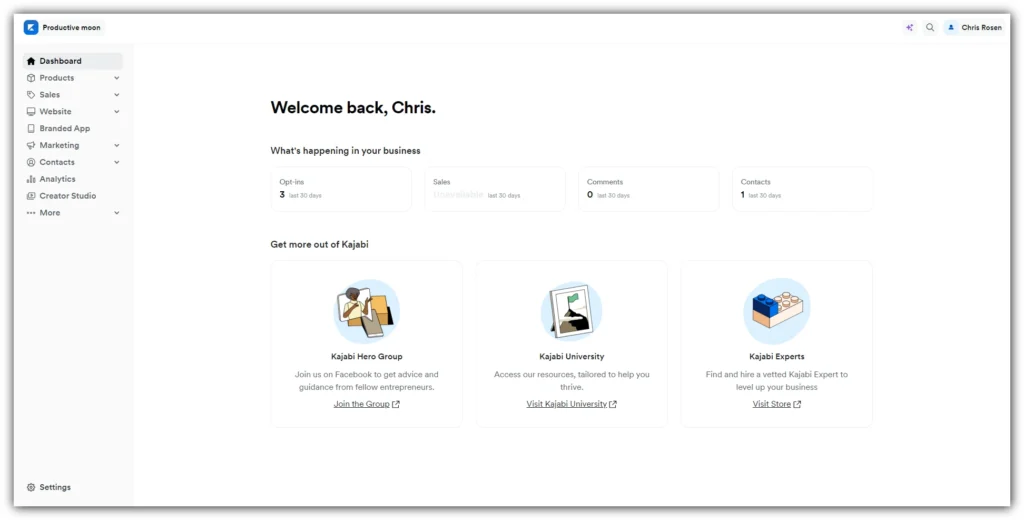
Kajabi focuses on being user-friendly with its clean and simple interface. The platform is organized well, so you can easily find what you need in no time.
When you log in, helpful prompts greet you and guide you through the platform’s features. This makes getting started easy.
Kajabi also has a strong help center. It offers comprehensive guides to assist you with any issues you might encounter.
Overall, the navigation and editing tools are smooth and enjoyable to use.
Shopify User Experience
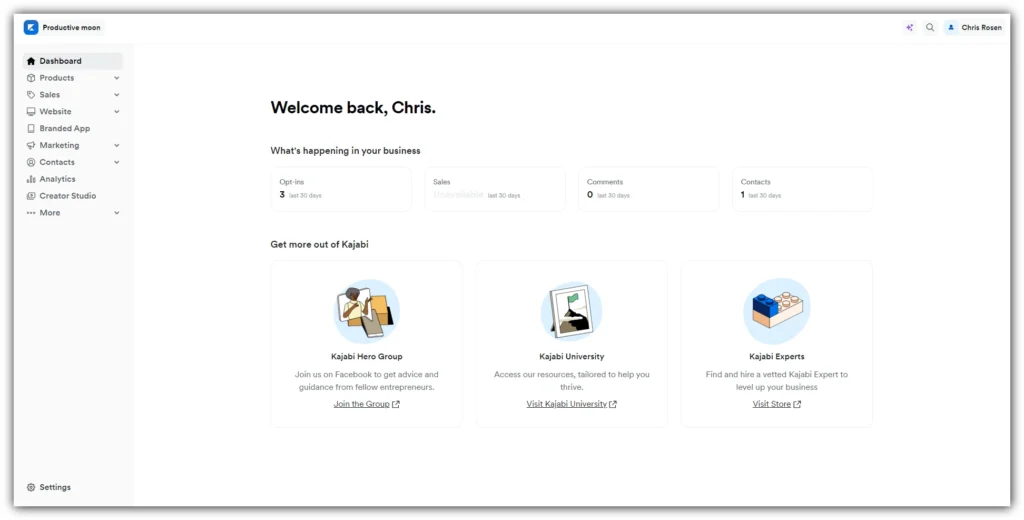
Shopify provides a lot of features, which can make things complex, especially when you’re using multiple third-party apps. The basic navigation is easy to understand, but as you explore its extensive editing tools and options, it can feel overwhelming.
While Shopify generally runs smoothly, its help center isn’t as helpful as it could be. Many users find themselves reaching out to customer service agents for assistance instead.
Winner: Kajabi
Kajabi’s user-friendly interface and well-organized structure make it more manageable for users, especially beginners. The platform also offers comprehensive guides and helpful prompts to assist with navigation and editing tasks. Shopify can feel cluttered and overwhelming, particularly when using multiple apps, making Kajabi the preferred option in terms of user experience.
Kajabi vs Shopify: Customer Service
Kajabi Customer Service

Kajabi provides strong customer support options, especially for users on higher-tier plans. If you’re on the basic plan, you can access live chat support from 6 AM to 5 PM Pacific Time. There’s also an email ticketing service available.
If you decide to upgrade to a higher plan, you’ll get 24/7 live chat support. Plus, you’ll receive a complimentary 30-minute call with a Kajabi onboarding specialist to help you get started.
Kajabi’s help center is user-friendly and well-organized. It features articles that include video walkthroughs, GIFs, and images. Most questions can be easily answered by consulting these beginner-friendly resources.
Shopify Customer Service
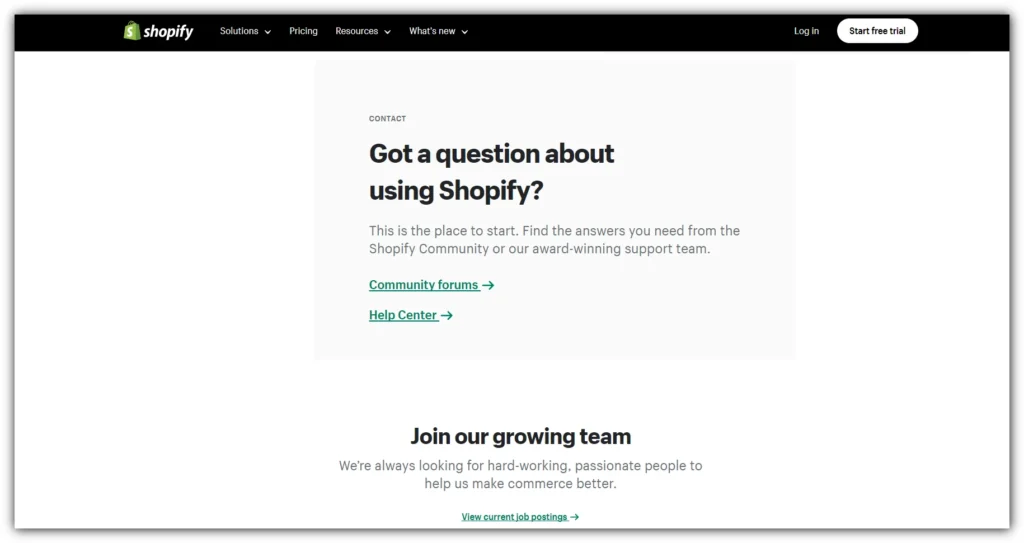
Shopify offers 24/7 support through live chat, email ticketing, and phone assistance on all plans. This means you can get help anytime you need it.
However, the help center can be less effective. Many users find it overwhelming because it features lengthy articles and lacks clear visuals. This often makes it difficult and frustrating to find specific information.
Overall, while Shopify provides excellent support, navigating the help center could use some improvement.
Winner: It’s a Draw
Shopify excels with its round-the-clock customer service and multiple contact methods, but its help center leaves much to be desired. Kajabi’s help center is outstanding and usually resolves issues effectively, but the lack of 24/7 support for all users is a drawback. Both platforms have their strengths and weaknesses in customer service, making this a balanced comparison.
Kajabi vs Shopify: Final Verdict
Choosing between Kajabi and Shopify can be challenging because each platform excels in different areas.
Kajabi is the preferred choice if you’re focused on creating, selling, and marketing digital products. Its features and tools are designed specifically for digital content, offering a well-rounded and integrated experience. However, if your goal is to sell physical products, Kajabi may not be the right fit.
Shopify, on the other hand, is ideal for those looking to sell physical products. It provides a robust e-commerce solution with extensive features for managing and growing your online store. However, it may not be as suitable for those looking to offer digital products or services.
In simple terms:
- If you’re creating and marketing digital products, use Kajabi.
- Choose Shopify for a comprehensive e-commerce platform to sell physical goods.
Conclusion
In the end, choosing between Kajabi and Shopify isn’t about picking the “best” platform – it’s about finding the right fit for your unique business needs. Both platforms offer powerful tools to help you succeed online, but they excel in different areas.
Kajabi stands out as the go-to choice for entrepreneurs focused on digital products, offering an all-in-one solution for creating, marketing, and selling courses, memberships, and coaching programs. On the other hand, Shopify reigns supreme in the world of e-commerce, providing robust features for selling physical products and scaling your online store.
Remember, there’s no one-size-fits-all solution in the digital business world. Take the time to consider your long-term goals, the types of products you want to sell, and the features that matter most to you. Don’t be afraid to take advantage of free trials to get a feel for each platform. If you want to get started with Kajabi, you can enjoy a 30-Day Free Trial!
Frequently Asked Questions
Are Kajabi and Shopify Similar?
While both Kajabi and Shopify are sales platforms, they cater to different needs. Kajabi focuses on creating and selling digital products, whereas Shopify is designed to sell both physical and digital items.
Which Platform is Better for E-Commerce – Kajabi or Shopify?
Shopify is superior for e-commerce. As a dedicated e-commerce solution, Shopify provides more advanced selling tools, including a dedicated checkout process and robust inventory management.
Which Platform is Better for Digital Products – Kajabi or Shopify?
Kajabi excels in handling digital products. It offers a range of tools for creating, marketing, and selling digital content. Shopify can sell digital products but requires external software for their creation.
Which Platform is More Cost-Effective – Kajabi or Shopify?
Shopify offers a more budget-friendly option for the lower-tier plans. However, both Kajabi and Shopify charge the same amount for their top-tier plans.
Can I Integrate Kajabi with Shopify?
Yes, you can integrate Kajabi with Shopify by using the Shopify Buy button. This allows you to sell physical products on your Kajabi web pages and funnels.